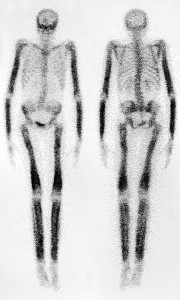All things considered, there are a number of cancers that form bone metastases (metastatic bone cancer, secondary bone cancer) such as breast cancer, prostate cancer, lung cancer, kidney cancer and thyroid cancer.
In any event, diagnostic tests such as a bone scan and general cancer diagnosis has to be done to establish the stage the cancer is in. Obviously, a bone biopsy can establish the histopathology of the cancer, which is helpful in finding the primary cancer location.
Multiple bone metastases
Unfortunately, on balance it is rare that only a single bone metastasis is found and it is more common that a bone metastasis is a sign that the original cancer is spreading into the rest of the body. In essence, there might be cancer cells that have spread to several vital organs including several locations of the bone anywhere in the body.
Likewise the first symptom of a bone metastasis may be a localized bone pain that prompts the physician to order X-rays, which show a lytic lesion (a calcium depleted bone metastasis). In this image there is a large area of lack of bone in the upper posterior end of the tibia bone in the knee of this patient. This is a lytic metastasis where the bone has been destroyed by cancer tissue from elsewhere in the body. Equally important, in contrast an osteoblastic metastasis where the metastasis is producing bony substance will show up as a hyper-intense focus on X-rays compared to the normal other bone. All in all, bone scans are more sensitive and detect bone metastases earlier.
Bone pain
Bone pain is usually the symptom that is first pointing to a bone lesion. Sometimes a pathological fracture can occur just below the hip joint and may be the first clue that there is a metastasizing cancer in the body.
Generally speaking it is not a good prognosis to have even a single bone metastasis as it indicates a stage IV of cancer (the worst stage of any cancer). Sometimes by treating the primary cancer, treating the bone metastasis with radiotherapy and helping the body to fight the remainder of the cancer, a few cancer patients are cured or get into a longer remission. Cancer chemotherapy occasionally helps in that regard as well (Ref. 8).
References
1. ABC of rheumatology, second edition, edited by Michael L. Snaith , M.D., BMJ Books, 1999.
2. The Merck Manual, 7th edition, by M. H. Beers et al., Whitehouse Station, N.J., 1999. Chapter 52.
3. The Merck Manual, 7th edition, by M. H. Beers et al., Whitehouse Station, N.J., 1999. Chapter 275,p.2429.
4. HA King Orthop Clin North Am 1988 Apr;19(2):247-255.
5. HA King Orthop Clin North Am 1999 Jul;30(3):467-474, ix.
6. The Merck Manual, 7th edition, by M. H. Beers et al., Whitehouse Station, N.J., 1999. Chapter 59.
7. JA Smith Orthop Clin North Am Jul 1999; 30(3): 487-499.
8. The Merck Manual, 7th edition, by M. H. Beers et al., Whitehouse Station, N.J., 1999. Chapter 56, p. 469.
9. Wheeless’ Textbook of Orthopaedics: http://www.wheelessonline.com/ortho/arthritis
10. Goldman: Cecil Textbook of Medicine, 21st ed.(©2000)W.B.Saunders
11. Ferri: Ferri’s Clinical Advisor: Instant Diagnosis and Treatment, 2004 ed., Copyright © 2004 Mosby, Inc.
12. Rakel: Conn’s Current Therapy 2004, 56th ed., Copyright © 2004 Elsevier







